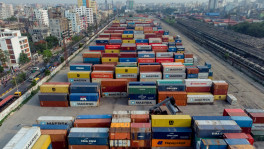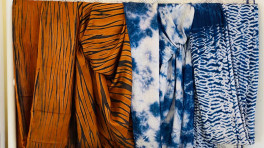‘Showgirls of Pakistan’ doesn’t need your victim narrative
In a new documentary about mujra dancers, Saad Khan escapes the Western documentary complex to give his subjects the chance to speak in their own words

When Saad Khan decided to make a documentary about Pakistan's mujra, or theater, dancers, he didn't expect the near-decade journey that would ensue. For him, making Showgirls of Pakistan started out with a couple of impromptu days of filming. Over seven years later, the project emerged as a feature-length documentary released globally this past January. To get the film out, he had to take on both the world's predominantly white-run documentary industry and Pakistan's mechanisms of social control at the same time.
Khan's film follows the lives of three mujra dancers, who practice an art form dating back to the Mughal Empire. For centuries, mujra dancers entertained pre-colonial Indian courts and their royals with evocative dance performances. Mujra was a respected art form, and the dancers were considered an important part of the cultural and social fabric of the Mughal Empire—not just because of their proximity to royalty, but because of their value as cultural assets. But after the British colonized India, things changed. The British colonists' efforts to impose their attitudes toward sex and sexuality on the local populations grew into a larger wave of conservatism. Mujra was eventually restricted and then outlawed.
"Mujra dancers were high taxpayers to the Mughal Empire, they had wealth and land," Khan, 31, said from his apartment in Brooklyn, New York, in March. "It made sense for a colonizing force to dismantle that support through laws, by force and propaganda. It was a means to seize their power." Eventually, Khan continued, "mujra was conflated with sex work and dancers with prostitutes, a supremely generalized narrative that exists and affects the lives of women in the business till now."
Mujra dancing still exists in what are now Pakistan and India, but in Pakistan, especially, it exists in a hypercommercial setting. Modern mujra performances can be seen in government-operated theaters, complete with ramshackle theatrical sets and props. A typical show would consist of comedic skits and scenes interpolated with high-energy dance numbers. The modern mujra audience consists of primarily working-class men, who come to be entertained by what many Pakistanis consider "vulgar" dances. Mujra is also often performed at private functions, where dancers are hired as the main form of entertainment.
The women of the mujra universe have to work hard to survive. And they face plenty of violence and death threats in real life and online while doing it. In 2016, for example, Kismat Baig, a dancer, was shot dead by unidentified gunmen in Lahore. The film highlights her and many others who have been shot, maimed, or killed.
But whereas another documentary might romanticize the image of suffering South Asian women as its main focus, Khan didn't want to fall into the victim narrative, even though, he said, Western film companies pushed him to do so as a condition for funding. Instead, Showgirls of Pakistan is a far grittier look at how the community in Pakistan powerfully maneuvers through misogyny, threats to life, and censorship in
Afreen Khan, Uzma Khan, and Reema Jaan are three dancers who come from different parts of the mujra world. The documentary follows them as they navigate the different stages of their careers and lives in and around Lahore and Multan. The first chapter follows Afreen Khan, a performer in Lahore who is steadily rising to fame. The second looks at Uzma Khan's life as she fights the patriarchal grip of the men who "manage" her career, and lastly, we see Jaan's hardships as a veteran theater star and a part of Pakistan's khwaja sara (third gender) community.
Khan's unflinching and empowering look at how these women actually live their lives has led to some criticisms of the film as resembling "PakPorn," referring to a hashtag used on porn sites for fetishizing South Asian Muslim women. "Ironically, the opening night film" at a festival where the director pitched Showgirls of Pakistan "was about mostly white showgirls in Vegas, who were topless and wearing tassels," Khan said. "That was not deemed as porn—in fact, there was a huge party for it. I was there, so was … the entire documentary industry, celebrating. But when it comes to Muslim women 'suggestively' dancing, in bodysuits mind you, it was somehow labeled as pornographic."
There is an element of colonialism in all this, Khan believes, with the funding determining what portrayals of Pakistani women get made: "Who are the gatekeepers? What are their limiting views about the world?" He points to a time when "white people would come to Pakistan to make films and do lousy translations and generalizations." That's why, he continued, "the media produced in the last few decades is so Orientalist, myopic, and always from a security lens. Security of whom? My team and I had to spend so much time deprogramming the commissioners before we could even get to what we had to offer." Undoing all that was exhausting, but the work shows. As Khan pointed out, "unlike many documentaries produced in Pakistan by Western channels, there is no call to action and nothing to 'save' in Showgirls of Pakistan."
And that can be empowering. The film gives more control to these women in how their narratives are portrayed, because it is contains plenty of footage they shot of themselves. In the final moments of the film Afreen Khan even tells the viewer herself: "Don't worry that I dance for a living or about what I do on the stage. Worry about yourself instead."Beyond the Western gaze, there's also the reception at home to contend with. Khan and his team started shooting the film in 2014 but had to halt production almost a year later when the first trailer of the documentary emerged. The crew received threats from extremist groups in Pakistan, so things went on hold for a while until it was safer to continue.
But Showgirls of Pakistan has an answer for the extremists, too. There is a moment in the film when Afreen Khan is watching a video of herself on stage. "These people want girls like me to feel so unsafe that they stop working," she said, referring to conservatives in her country. "If I was intimidated, I would never have left the house to work in the first place. If I ran the government, I would have all men castrated. … All problems would be solved. Is anyone feeding me? Tell me who is? If someone has a problem with my work, they can put food on the table first. Even if I was in a burqa, they'd still be after me."
Born and raised in a working-class neighborhood in Lahore, Khan said he wanted to show the complexity of life he grew up around—a life that was rarely, if ever, portrayed in any sincere way in Pakistani media. "If there was ever a poor person on TV they would always be this two-dimensional character, where all they were was poor. That's it," he said. "Why is nuance only for those in power?"
It shouldn't be, Khan said, and Jaan is a case in point. Jaan, who features in the third chapter of the documentary, passed for a cisgender woman for a long time in her life, until police raided a party she was performing at and she was arrested. After that, it became publicly known that she was a khwaja sara.
In the film, she had her own internal battles within the third gender community over working in an area without permission from her guru (a khwaja sara leader who guides their community). She is happy with the outcome of the film, though: "I'm speechless with the film. All credit goes to Saad. He portrayed us beautifully. People who had forgotten me in life are now reconnecting once again, and it's giving me more opportunities."
At one point, Khan and the crew rented a studio in Lahore for Afreen Khan and Jaan to have a private space where they could direct their own dance sequences for the film. This was another means for them to tell their own stories. The performance shots, which are interspersed throughout the film, remind the audience that behind the layers of oppression and suppression of mujra dancers, mujra first and foremost is an art form.
Jaan has faced a lot of violence throughout her dancing career—she'd been abducted and stalked in the past. And since 2015, at least 73 members of the khwaja sara community have been killed by assailants in Pakistan, according to Pakistan's Transgender Association. Another local group, Trans Action, documented 479 attacks on trans women in the Khyber Pakhtunkhwa province in 2018 alone.
But in Khan's film, these people are more than just a statistic—they are three-dimensional human beings with complex lives who exist beyond the pain and violence they face on a regular basis. The viewer gets to experience the joys and sorrows of being a working-class woman in the world of mujra with them. And for many of them, having such a portrayal out in the world has been redeeming. "I was dying, vanishing, ceasing to exist, and Saad brought life back into me," Jaan told me. "He resurrected me. I'm now Reema Jaan again."
Zab Mustefa is a Scottish Pakistani journalist.
Disclaimer: This article first appeared on Foreign Policy, and is published by special syndication arrangement


 Keep updated, follow The Business Standard's Google news channel
Keep updated, follow The Business Standard's Google news channel
















